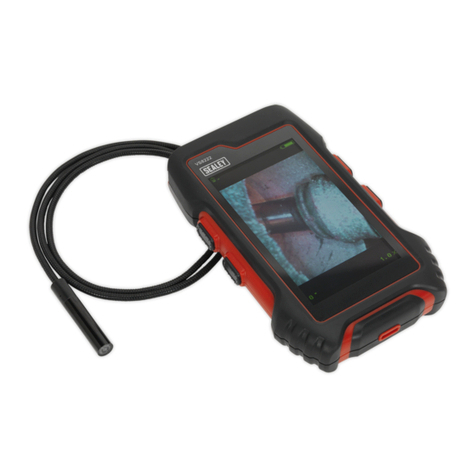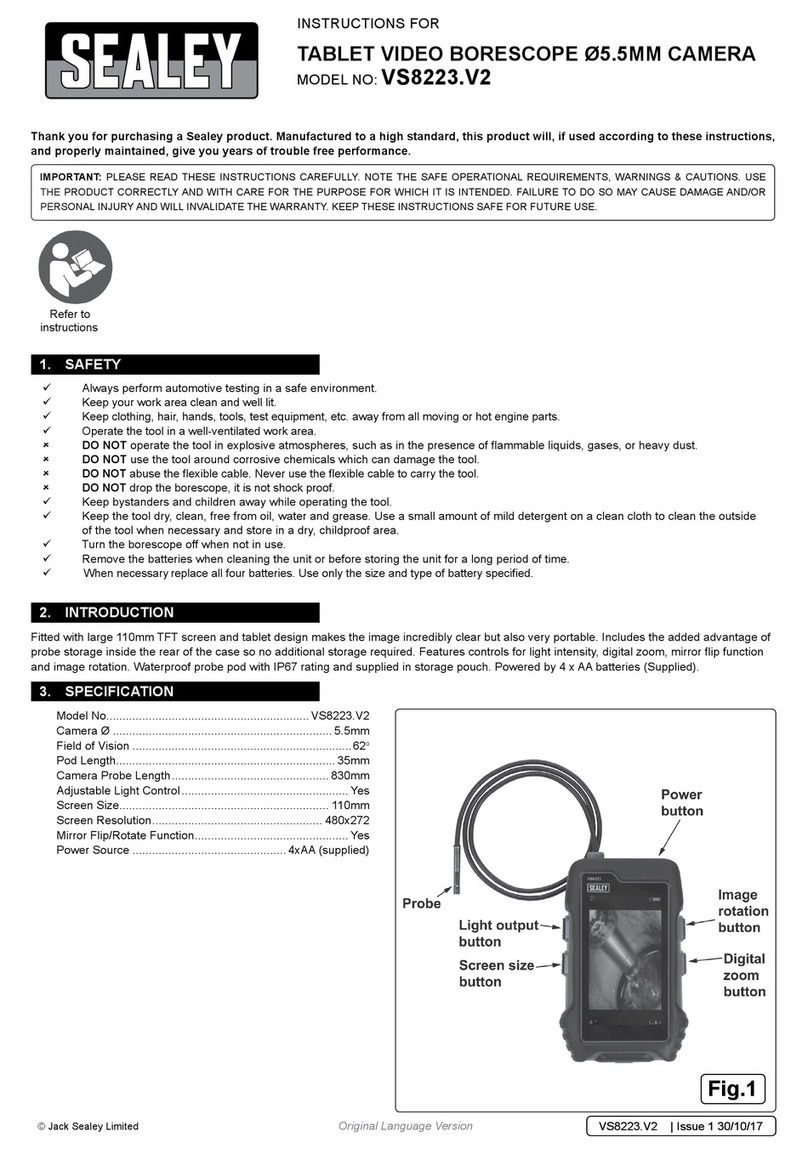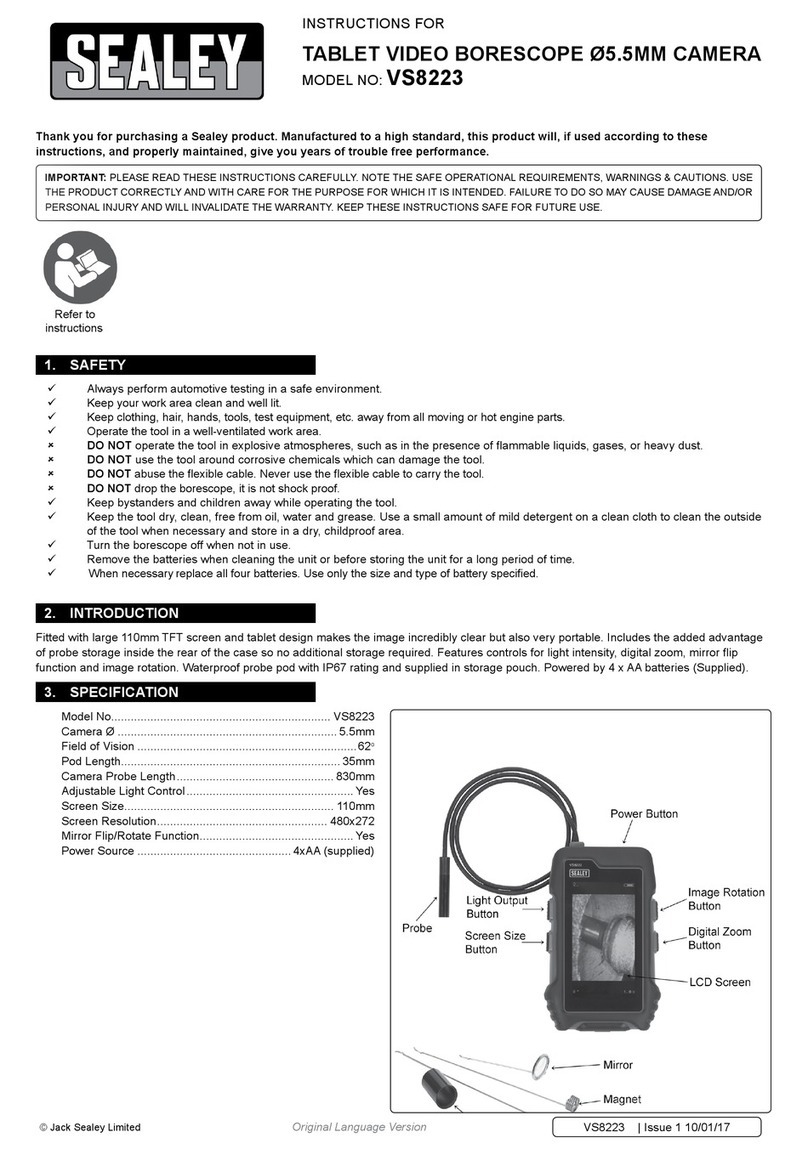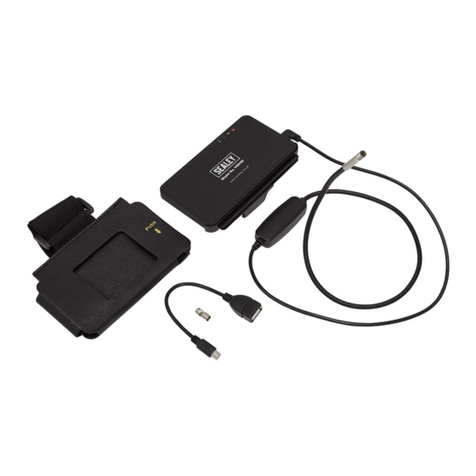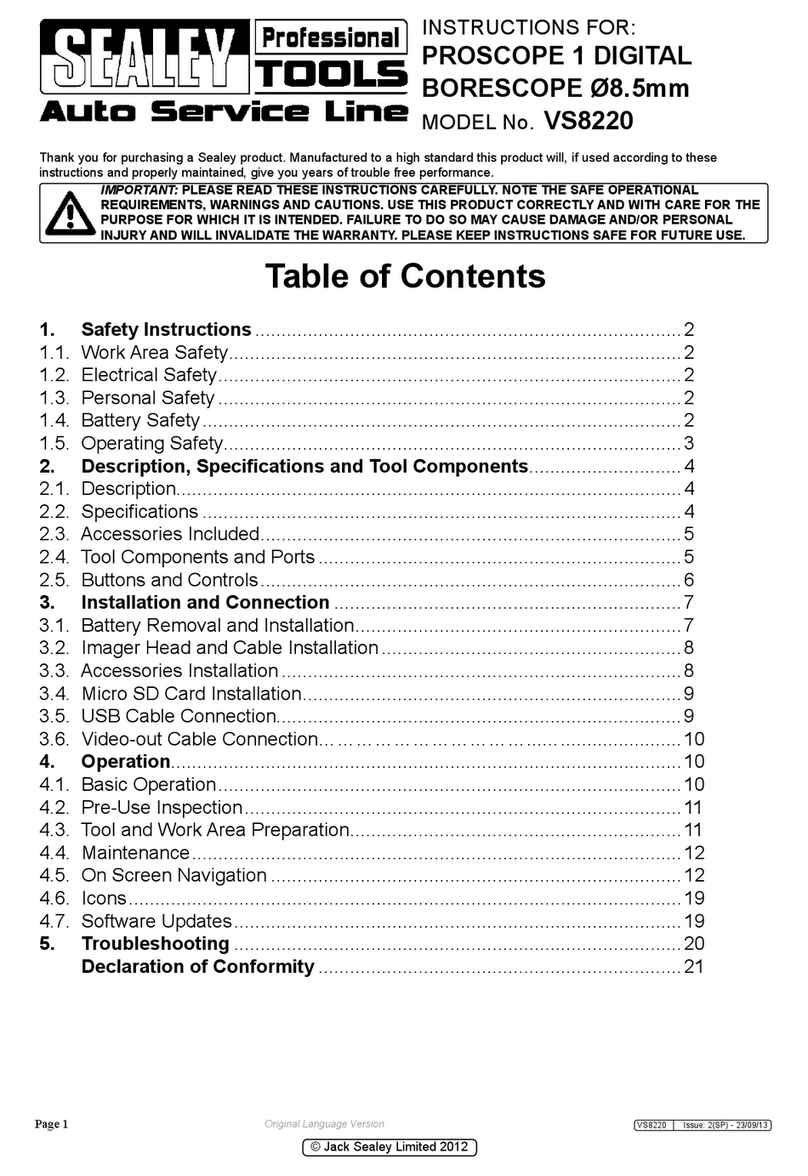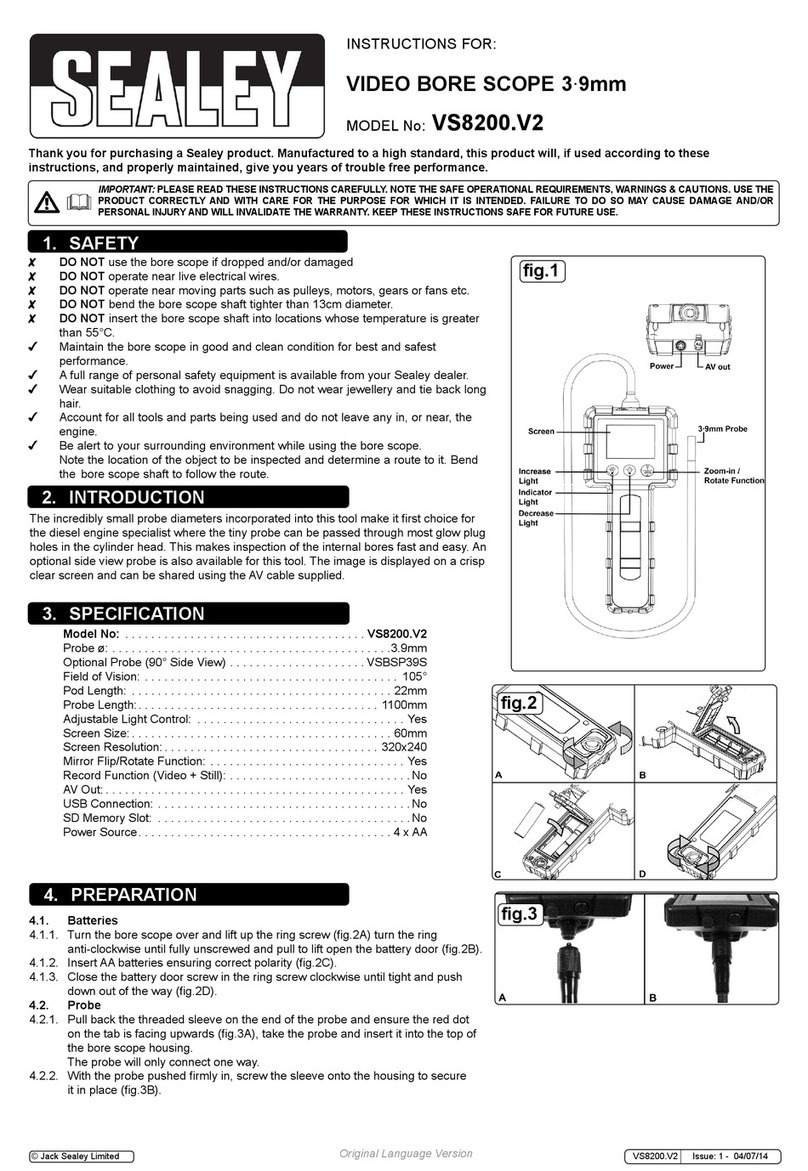
1.1. GENERAL SAFETY
7DO NOT use the bore scope if dropped and/or damaged
7DO NOT operate near live electrical wires.
7DO NOT operate near moving parts such as pulleys, motors,
gears or fans etc.
7 DO NOT bend the bore scope shaft tighter than 2.5 inch radius
(5 inch diameter).
7 DO NOT expose the bore scope housing to water or other liquids.
7 DO NOT insert the bore scope shaft into locations whose
temperature is greater than 45°C.
Maintain the bore scope in good and clean condition for best and
safest performance.
A full range of personal safety equipment is available from your
Sealey dealer.
Wear suitable clothing to avoid snagging. Do not wear jewellery
and tie back long hair.
Account for all tools and parts being used and do not leave any
in, or near, the engine.
Be alert to your surrounding environment while using the bore
scope.
Note the location of the object to be inspected and determine a
route to it. Bend the bore scope shaft to follow the route.
1.2. MAINS POWER ELECTRICAL SAFETY (In relation to the
battery charger)
WARNING! It is the owner’s responsibility to check the
following: You must check all electrical equipment and
appliances to ensure they are safe before using. You must
inspect power supply leads, plugs and all electrical connections
for wear and damage. You must ensure that the risk of electric
shock is minimised by the installation of appropriate safety
devices. An RCCB (Residual Current Circuit Breaker) should be
incorporated in the main distribution board. We recommend that
an RCD (Residual Current Device) is used with all electrical
products. It is particularly important to use an RCD with portable
products that are plugged into a supply not protected by an
RCCB. If in doubt consult a qualified electrician. You may obtain
an RCD by contacting your dealer. You must also read and
understand the following instructions concerning electrical safety.
1.1.1. The Electricity At Work Act 1989 requires all portable electrical
appliances, if used on business premises, to be tested by a
qualified person, using a Portable Appliance Tester (PAT), at
least once a year.
1.1.2. The Health & Safety at Work Act 1974 makes owners of
electrical appliances responsible for the safe condition of the
appliance and the safety of the appliance operator. If in any
doubt about electrical safety, contact a qualified electrician.
1.1.3. Ensure that the insulation on all cables and the product itself is
safe before connecting to the mains power supply. See 1.3.1.
above and use a Portable Appliance Tester (PAT).
1.1.4. Ensure that cables are always protected against short circuit and
overload.
1.1.5. Regularly inspect power supply leads, plugs and sockets for wear,
damage or loose connections.
1.1.6. Check that the voltage marked on the product is the same as the
power supply to be used and check that the plug is fitted with the
correct capacity fuse.
1.1.7. DO NOT pull or carry the appliance by attached leads.
1.1.8. DO NOT pull plug from socket by the power cable.
1.1.9. DO NOT use worn or damaged cables, plugs or connectors.
Immediately have any faulty item repaired or replaced by a
qualified electrician.
Thank you for purchasing a Sealey Product. Manufactured to a high standard this product will, if used according to these instructions
and properly maintained, give you years of trouble free performance.
IMPORTANT: PLEASE READ THESE INSTRUCTIONS CAREFULLY. NOTE THE SAFE OPERATIONAL REQUIREMENTS,
WARNINGS AND CAUTIONS. USE THIS PRODUCT CORRECTLY AND WITH CARE FOR THE PURPOSE FOR WHICH IT IS
INTENDED. FAILURE TO DO SO MAY CAUSE DAMAGE AND/OR PERSONAL INJURY AND WILL INVALIDATE THE
WARRANTY. PLEASE KEEP INSTRUCTIONS SAFE FOR FUTURE USE.
1. SAFETY INSTRUCTIONS
INSTRUCTIONS FOR:
VIDEO BORE SCOPE Ø6mm x 1000mm
MODEL No:
VS8195
2. INTRODUCTION
Suitable for internal inspection of cylinder head bores, engine
compartments and other machinery/industrial applications. Flexible
shaft diameter is small enough to t through most spark/glow plug and
injector apertures. Features three tip mounted mirrors 30º , 45º and 60º
allowing a clear view in conned spaces. A magnetic attachment is also
included. Capable of taking photos/videos which can be viewed on a
computer via the SD card. Ideal for warranty authorisation. Supplied
with SD card, AV cable, battery charger and comprehensive instructions
in carry-case.
3. SPECIFICATION
Probe Diameter .......................................6mm
Probe Length ......................................1000mm
Minimum Bend Radius ..............................2.5”/64mm
Camera..................................Automatic exposure
Camera viewing Angle ................................... 67°
Light source .......................................4 x LEDs
Screen .....................................3.5” LCD Monitor
Screen resolution . . . . . . . . . . . . . . . . . . . . . . . . . . . . . 320 x 240 pixels
LCD ...............................................Colour
Video Format ...................................NTSC & PAL
Battery ...................................3.7V Rechargeable
Charger......................................110V - 230V(LI)
Flash memory storage ...........................2GB SD Card
Compression Format .................................MPEG4
VS8195 Issue No:1 01/06/09
g.1
1.3. BATTERY CHARGER SAFETY INSTRUCTIONS
WARNING! DO NOT attempt to charge any battery other than
that supplied for the bore scope. Other types of batteries may
explode!
All mains electrical supply safety features must be followed as
described in Section 1.1.
Disconnect the charger from the mains power supply when not in
use.
DO NOT expose the charger to damp or wet conditions.
DO NOT pull or carry the charger by the power lead.
DO NOT operate the charger if it has been dropped, received a
sharp knock, or is damaged. Take charger to an authorised agent.
DO NOT dismantle the charger as this may cause damage or
personal injury and will invalidate your warranty.






